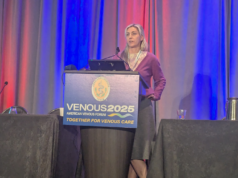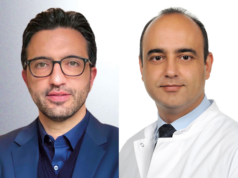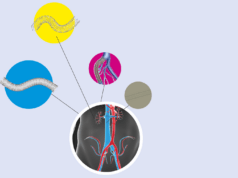
Deep venous stenting has become increasingly used to treat patients with pathological obstruction of venous return in the femoro-iliocaval venous segment following the development of new dedicated venous stents. Patients treated range from those with an isolated non-thrombotic iliac vein lesion, to those with extensive post-thrombotic disease requiring extensive reconstruction. In this commentary article, Adam Gwozdz writes that the challenges when treating these different groups of patient can vary and the postoperative anticoagulation management often requires personalisation.
One of the biggest challenges when treating patients with any stent is maintaining patency. Venous stent patency is likely influenced by a number of factors including those associated with the patient, their operation (and underlying problem), and the type of postoperative anticoagulation used.
Clinical guidelines from the National Institute for Health and Care Excellence (NICE) in the UK recommend the use of direct oral anticoagulants (DOACs), rivaroxaban, dabigatran, apixaban, or edoxaban, as options for treating deep vein thrombosis and pulmonary embolism, and preventing long-term recurrence. However, their guidance does not extend to use in patients with venous stents. At present, there is no evidence to suggest that one anticoagulant is superior in preventing post-procedure in-stent thrombosis, and anticoagulation choice is therefore largely personal. Our deep venous stenting programme at St Thomas’ Hospital involves review of all patients by a multidisciplinary team with a view to optimising anticoagulation on an individualised basis given the heterogeneity of the population we treat. In the immediate postoperative period, all patients have two weeks of therapeutic low molecular weight heparin (LMWH) (the exception being patients with anti-thrombin deficiency) followed by transition to warfarin with a target internalised ratio (INR) of 2–3 (unless a higher range is indicated due to haematological comorbidities). The use of a LMWH lead in is based on the available evidence from the venous thromboembolism literature and the potential anti-inflammatory pleiotropic effects of LMWH.
Transition to oral anticoagulation is based upon outcomes from ultrasound surveillance scans, with early reintervention possible without the need to wait or correct the INR. Active monitoring gives the ability to ensure that an appropriate therapeutic window is maintained, which can be more difficult with some of the DOACs, and as it has been used for many years there is a good understanding of the pharmacokinetics of warfarin.
Long-term anticoagulation is largely tailored to individual patients under guidance from our haematological colleagues who form a vital component of our clinical team. However, despite sufficient therapeutic anticoagulation, we still see radiological evidence of in-stent thrombosis occurring in a number of the patients that we treat, with those who had a stent following an acute iliofemoral deep vein thrombosis or following post-thrombotic reconstruction most affected.
Little is known about the pathogenesis of thrombosis complicating venous stent patency. Given that in-stent thrombosis can occur despite full anticoagulation, it has been proposed that thrombi occurring in this setting may represent a platelet-driven process similar to that seen following arterial stenting. Further evidence supporting this hypothesis include: the persistence of a platelet pro-coagulant surface expression following stenting; platelet-leukocyte interactions; and evidence that platelet inhibition with aspirin results in risk reduction of venous thromboembolism recurrence. However, these findings are not enough to support the routine use of antiplatelets and further investigation is needed to understand if and why an antiplatelet may have a role, particularly given the potential increase in major bleeding as a consequence of the addition of anti-platelets in patients on full anticoagulation.
Additional drug strategies that may be beneficial and require further research include the potential role of statins, possible use of immune suppression to limit early inflammatory mediated thrombosis and the potential for drug-eluting balloons or stents.
Future research will also need to focus on defining which patients benefit the most from heparin lead-in, the use of DOACs and deciding optimal treatment duration following stenting. Regardless, the anticoagulation strategy is likely to be tailored to the individual, taking into account patient preference, compliance, comorbidities, polypharmacy, bleeding risk, aetiology of the deep vein thrombosis and risk or recurrence. This can only be achieved by continuing to develop strong collaborative networks, and by working closely with our haematological colleagues. Until further data is available however, which may guide appropriate management, we advocate surveillance of all patients and early intervention if required.
Adam Gwozdz is an NIHR Academic Clinical Fellow in Vascular Surgery at King’s College London, London, UK












